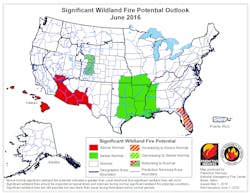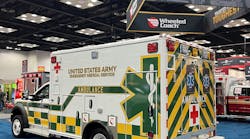Federal officials expect that this year's wildfire season will be another bad one.
"We are looking at some problems in different areas," BLM Deputy Chief of External Affairs Jessica Gardetto said earlier this week. “So far we have burned more acres this year than last year.”
Gardetto noted that a series of fires in Oklahoma destroyed over 300,000 acres, and "typically we don’t see fires that large in the winter months."
Some parts of Alaska are bone dry and it's the same problem in southern California.
"Alaska received very little snow pack, they’re just experiencing the results of climate change," Gardetto said. "They had a bad fire year last year and it appears that they could have another bad one this year. California has been in a drought for so long that one good snow year doesn't make up for a drought."
The northwest and Rocky Mountain areas will see a decreased threat.
The National Interagency Fire Center publishes the National Wildland Significant Fire Potential Outlook website with briefings that are updated daily and monthly. That data is collected by the National Predictive Services to help fire directors coordinate resources.
According to the report, southern Nevada, Arizona, New Mexico and Hawaii also face above-normal fire threats in June. Most of Florida will have a higher-than-normal threat. In July and August, California, Hawaii, Nevada and Idaho will higher than normal wildfire potential.
Gardetto said that the National Weather Service's Fire Weather Forecast website is a great resource for fire districts to monitor their local conditions. It includes data on fuel moisture, humidity, storms and dry lightning.
Moving firefighting resources
Federal and local officials carefully monitor weather conditions daily and that helps them position resources where they might be needed.
“If we think we’re going to get dry lightning in southern Nevada, they will say we might need to move more resources there to get ahead of it,” Gardetto said.
That could include aircraft, helicopters, smoke jumpers and hand crews.
"We can fly crews anywhere," she said. “While hand crews can be moved by air, their vehicles still need to be driven to incidents.”
U.S. agencies helping out in Canada
The massive Fort McMurray wildfire in Alberta, Canada, required so many Canadian resources that U.S. crews have crossed the border to lend a hand. Two air tankers were sent to Canada to help crews battle other fires.
The Canadian Interagency Fire Center requested 10 hand crews earlier this week and U.S. officials were looking for teams that were able to deploy.
“It's a hard time of the year to deploy that many crews,” Gardetto said, noting that most teams are completing their training and preparing their equipment and vehicles. "We're glad to help them out."






